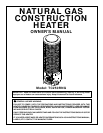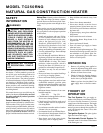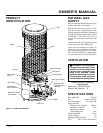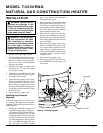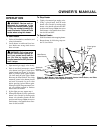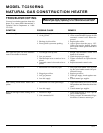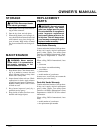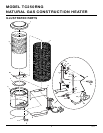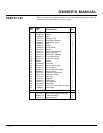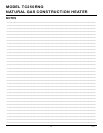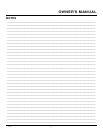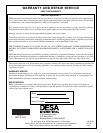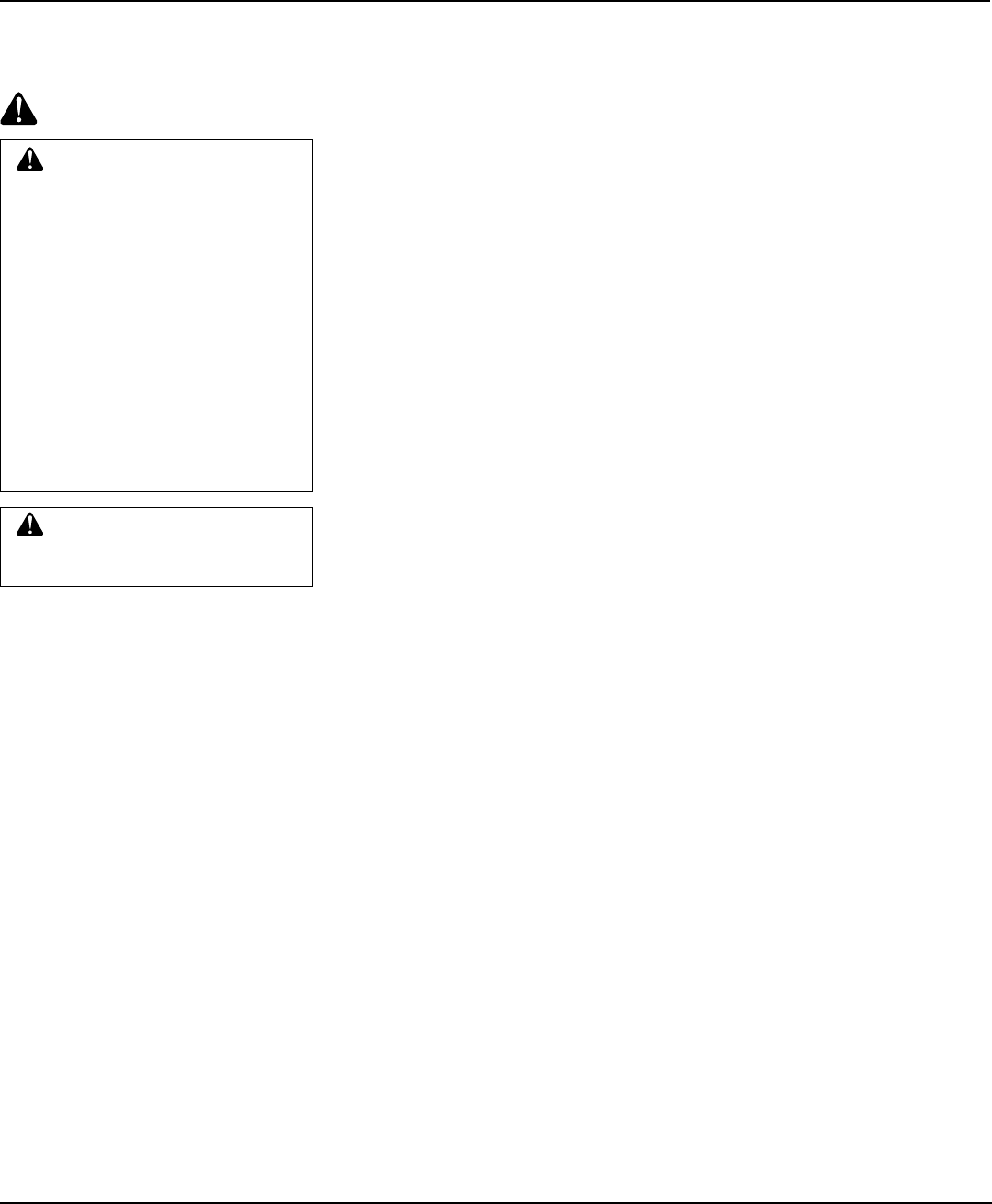
2
104133
NATURAL GAS CONSTRUCTION HEATER
MODEL TC250RNG
THEORY OF
OPERATION
The Fuel System: The gas supply at-
taches to the heater by a minimum 3/8 inch
i.d. hose or flexible connector. User must
supply hose or flexible connector. The length
should be no more than 10 feet long. The
natural gas moves through the regulator (if
used) and through the control valve, then
out the nozzle.
The Ignition System: The piezo ignitor
lights the burner fuel supply.
The Automatic Control System: The
automatic control valve shuts off the heater
if the flame goes out.
1. Remove all packing items applied to
heater for shipment. Keep plastic cover
caps (attached to valve inlet) for storage.
2. Remove all items from carton.
3. Check all items for shipping damage.
If heater is damaged, promptly inform
dealer where you bought heater.
Note:
A gas hose is not included. User
must supply hose or flexible connec-
tor.
UNPACKING
SAFETY
INFORMATION
WARNING: FIRE, BURN, IN-
HALATION, AND EXPLOSION
HAZARD. KEEP SOLID COMBUS-
TIBLES, SUCH AS BUILDING MA-
TERIALS, PAPER OR CARD-
BOARD, A SAFE DISTANCE
AWAY FROM THE HEATER AS
RECOMMENDED BY THE IN-
STRUCTIONS. NEVER USE THE
HEATER IN SPACES WHICH DO
OR MAY CONTAIN VOLATILE OR
AIRBORNE COMBUSTIBLES, OR
PRODUCTS SUCH AS GASO-
LINE, SOLVENTS, PAINT THIN-
NER, DUST PARTICLES OR UN-
KNOWN CHEMICALS.
WARNING: NOT FOR HOME
OR RECREATIONAL VEHICLE
USE.
WARNINGS
The heater is designed for use as a construc-
tion heater. Certain standards govern the
use of fuel gases and heating products for
specific uses. Your local authority can ad-
vise you about these. The primary purpose
of construction heaters is to provide tempo-
rary heating of buildings under construc-
tion, alteration or repair. Properly used, the
heater provides safe economical heating.
Products of combustion are vented into the
area being heated.
We cannot foresee every use which may be
made of our heaters. Check with your local
fire safety authority if you have questions
about heater use.
Carbon Monoxide Poisoning: Some
people are more affected by carbon monox-
ide than others. Early signs of carbon mon-
oxide poisoning resemble the flu, with head-
aches, dizziness, and/or nausea. If you have
these signs, the heater may not be working
properly. Get fresh air at once! Check for
proper ventilation and have heater serviced.
Natural Gas: Natural gas has a distinctive
odor. This odor helps you detect a natural
gas leak. However, the odor may fade. Natu-
ral gas may be present even though no odor
exists.
Make certain you read and understand all
Warnings. Keep this manual for reference.
It is your guide to safe and proper operation
of this heater.
• Install and use heater with care. Follow
all local ordinances and codes. In the
absence of local ordinances and codes,
refer to the National Fuel Gas Code
Handbook, NFPA54/ANSI Z223.1 and
the Natural Gas Installation Code, CAN/
CGA B149.2. This instructs on the safe
storage and handling of flammable gases.
• Use only with natural gas. Do not attempt
to use with LP gas.
• Provide adequate ventilation. Before us-
ing heater, provide at least a three-square-
foot opening of fresh, outside air for each
100,000 Btu/Hr of rating. This heater
produces carbon monoxide, which is
listed by the State of California as a re-
productive toxin under Proposition 65.
• For indoor use only. Do not use heater
outdoors.
• Do not use heater in occupied dwellings
or in living or sleeping quarters.
• Do not use heater below ground level.
• Keep appliance area clear and free from
combustible materials, gasoline, paint
thinner, and other flammable vapors and
liquids. Do not use heater in areas with
high dust content.
• Minimum heater clearances from com-
bustible materials:
Sides: 6 Ft. Top: 5 Ft.
• Check heater for damage before each use.
Do not use a damaged heater.
• Check hose (if used) before each use of
heater. If highly worn or cut, replace be-
fore using heater.
• Locate heater on stable and level surface
if heater is hot or operating.
• Not intended for use on finished floors.
• Never block air inlet (bottom of shell) or
air outlet (top of shell) of heater.
• Keep heater away from strong drafts,
water spray, rain, or dripping water.
• Keep children and animals away from
heater.
• Do not leave heater unattended.
• Never move, handle, or service a hot or
operating heater. Severe burns may res-
ult. You must wait 20 minutes after turn-
ing heater off.
• To prevent injury, wear gloves when han-
dling heater.
• Never attach duct work to heater.
• Do not alter heater. Keep heater in its
original state.
• Do not use heater if altered.
• Turn off natural gas supply to heater
when not in use.
• Use only original replacement parts. This
heater must use design-specific parts. Do
not substitute or use generic parts. Im-
proper replacement parts could cause
serious or fatal injuries.



